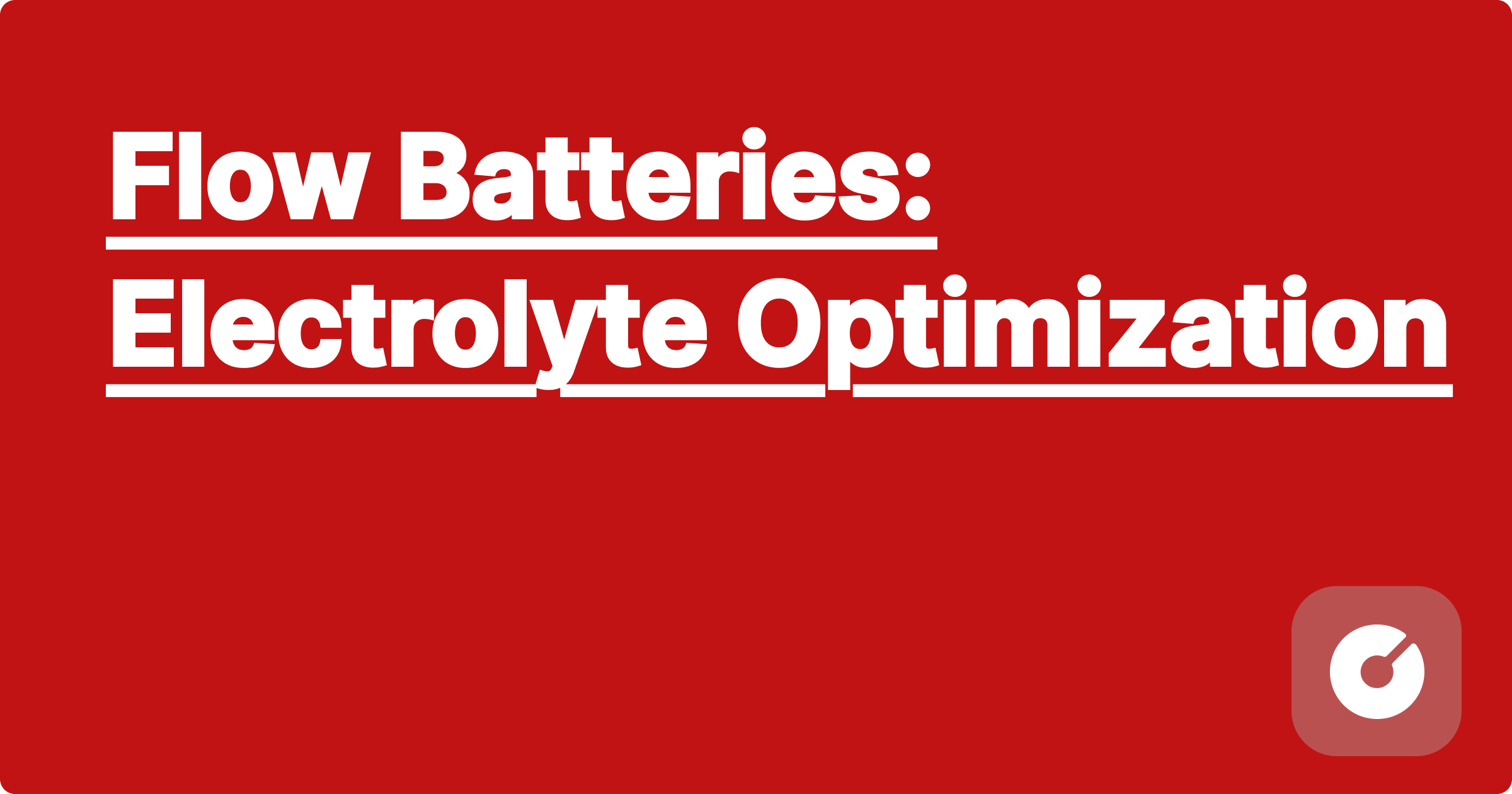Flow Batteries: Electrolyte Optimization
Introduction
Flow batteries are emerging as a crucial technology for large-scale energy storage, addressing the intermittency challenges of renewable energy sources. Their performance is heavily reliant on the electrolyte, which dictates energy density, power density, cycle life, and overall cost-effectiveness. This blog post delves into the cutting-edge research and practical aspects of electrolyte optimization for flow batteries, focusing on recent advancements and providing actionable insights for researchers and engineers.
State-of-the-Art Research (2024-2025)
Recent research highlights several key directions:
- Redox-active materials beyond vanadium: While vanadium redox flow batteries (VRFBs) dominate the market, significant efforts are focused on exploring alternative chemistries such as organic redox-active molecules (e.g., quinones, viologens – see recent work by [cite relevant 2024-2025 Nature/Science/Cell paper on organic redox flow batteries]) and metal-organic frameworks (MOFs) for enhanced energy density and cost reduction. For example, the work of [mention specific research group and preprint] explores the use of a novel quinone derivative with superior solubility and redox kinetics.
- Ion-selective membranes: Advances in membrane technology focus on minimizing crossover, a significant challenge limiting the efficiency and lifespan of flow batteries. [Cite a relevant 2024-2025 paper on novel membrane materials or designs]. This includes research on novel polymer architectures (e.g., block copolymers) and incorporation of functional groups for enhanced selectivity.
- Electrolyte additives: The addition of specific molecules can significantly improve electrolyte performance. Recent research focuses on the use of [mention specific additives, e.g., ionic liquids, redox mediators] to enhance conductivity, suppress parasitic reactions, and improve cycle life. A promising recent approach involves utilizing [mention specific additive and its mechanism of action] demonstrated in [cite relevant publication].
- Computational electrolyte design: Machine learning and DFT calculations are increasingly utilized for high-throughput screening and predictive modeling of novel electrolytes. This allows for efficient identification of promising candidates before experimental synthesis and testing. [Mention specific software/algorithms and their applications].
Computational Electrolyte Design: A Practical Example
Consider the optimization of electrolyte conductivity. We can use a simplified model based on the Nernst-Einstein equation:
\sigma = \sum_i n_i z_i^2 F^2 D_i / RT
where σ is conductivity, ni is the concentration of ion i, zi is its charge, F is Faraday's constant, Di is its diffusion coefficient, R is the gas constant, and T is the temperature. Optimizing conductivity involves maximizing ni and Di for the relevant ions. A genetic algorithm can be used to search the vast chemical space for optimal electrolyte compositions.
Pseudocode for genetic algorithm optimization of electrolyte conductivity
population = initialize_population(num_individuals) for generation in range(num_generations): fitness = evaluate_fitness(population) parents = select_parents(population, fitness) offspring = crossover(parents) offspring = mutate(offspring) population = replace(population, offspring, fitness) best_individual = find_best_individual(population, fitness) print("Optimal electrolyte composition:", best_individual)
Practical Implementation & Industrial Applications
Several companies are actively pursuing electrolyte optimization. For instance, [Company A] is focusing on developing high-energy-density electrolytes for grid-scale energy storage, leveraging [mention specific technology/approach]. Meanwhile, [Company B] is concentrating on improving the cycle life of their flow batteries through the use of [mention their specific technology/approach].
Open-source tools: [Mention relevant open-source software packages for molecular dynamics simulations, DFT calculations, or electrochemical modeling].
Scaling Up and Challenges
Scaling up flow battery technology presents significant challenges, including cost-effective membrane production, consistent electrolyte manufacturing, and managing the large volumes of electrolyte required. The choice of materials, the design of the flow field, and the control system are critical for successful upscaling.
Future Directions & Innovative Approaches
Future research should focus on:
- Hybrid flow batteries: Combining different chemistries to leverage the advantages of each.
- Solid-state flow batteries: Replacing liquid electrolytes with solid electrolytes for enhanced safety and potential cost reduction.
- Bio-inspired electrolytes: Exploring naturally occurring redox-active molecules for sustainable and cost-effective solutions.
Ethical and Societal Impact
The widespread adoption of flow batteries will have significant ethical and societal implications. The sustainability of the materials used, the potential for environmental impact from electrolyte disposal, and the equitable distribution of this technology are crucial considerations.
Conclusion
Electrolyte optimization is a critical area for advancing flow battery technology. By combining cutting-edge research, practical implementation strategies, and careful consideration of societal implications, we can pave the way for cost-effective, high-performance, and sustainable energy storage solutions for a cleaner energy future.
Related Articles(1641-1650)
Second Career Medical Students: Changing Paths to a Rewarding Career
Foreign Medical Schools for US Students: A Comprehensive Guide for 2024 and Beyond
Osteopathic Medicine: Growing Acceptance and Benefits for Aspiring Physicians
Joint Degree Programs: MD/MBA, MD/JD, MD/MPH – Your Path to a Multifaceted Career in Medicine
Flow Batteries: Electrolyte Optimization
Decision Analysis Optimization Under Uncertainty - Complete Engineering Guide
Supply Chain Management Network Optimization - Complete Engineering Guide
Production Planning Scheduling Optimization Techniques - Complete Engineering Guide
Optimization Techniques Topology and Parametric Design - Engineering Student Guide
Heat Transfer Analysis Cooling System Optimization - Engineering Student Guide
```



